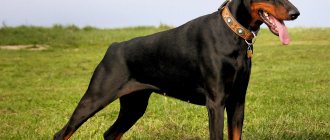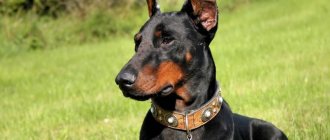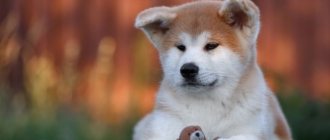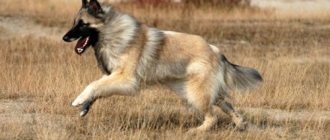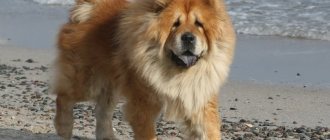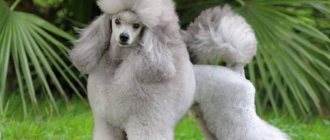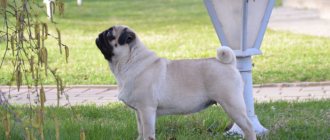The Doberman is a strong and intelligent dog. The breed was bred for service purposes, but now these dogs are not as aggressive as before. They are graceful, smart and loyal. Often used for guarding or protection, but can become a companion or pet. They have a very keen sense of smell and a developed instinct to protect their territory. Therefore, the Doberman breed has remained one of the most popular for many years.
- Head
- Training
- Nutrition
Breed traits
Breed traits (on a 5-point scale)
| Doberman (Doberman pinscher) | |||
| Activity | in the house | 2.9 | |
| on the street | 4.3 | ||
| Obedience | training | 4.2 | |
| strangers | 4 | ||
| Domination | in family | 2.1 | |
| over dogs | 2.8 | ||
| Defending your territory | from people | 3.5 | |
| from dogs | 3.6 | ||
| Sociability | in family | 4.9 | |
| with strangers | 3.1 | ||
| with dogs | 3.2 | ||
| Concentration | in family | 1.1 | |
| in front of strangers | 2.2 | ||
| with dogs | 2 | ||
| Aggressiveness | in family | 1.1 | |
| to strangers | 2.6 | ||
| to the dogs | 2.5 | ||
| to cats | 3 | ||
| Family behavior | calmness | 4.5 | |
| demand for affection | 4.6 | ||
| excitability | 4.1 | ||
| playfulness | 4.3 | ||
| excessive barking | 2.1 | ||
| behavioral breakdowns | 2.2 | ||
| Tolerance for children | up to 4 years | 3.4 | |
| over 4 years old | 3.8 | ||
| Institutional use | watchman | 4.7 | |
| bodyguard | 3.5 | ||
This breed is often compared to the following dog breeds: German Shepherd, Great Dane, American Staffordshire Terrier, Bull Terrier, Rottweiler.
Photos show how beautiful and elegant Dobermans are:
Exercise requirements
One of the most important aspects when deciding whether a Doberman is right for your family is to consider how active your family is. These dogs need a lot of exercise to keep them happy and relieve stress.
If your family is constantly walking or biking, hiking, or just running around playing outdoor games, then this would be a great dog for you. In fact, you may find that your Doberman will outplay your children and tire them out. If your family is less active and stays at home a lot, this may not be the best choice.
There are many dog breeds that are bred as companion dogs and they will be completely happy to spend hours relaxing on your lap in the house. The Doberman Pinscher is not one of them.
Doberman: general characteristics
The Doberman is an artificially bred breed. Its founder, Louis Dobermann, had the goal of having a strong, fearless and intelligent defender. Therefore, he crossed the most intelligent, hardy and evil dogs. The first dogs were even aggressive and were used for police service and security. Now Dobermans have become calmer and safer dogs, retaining all other positive qualities.
Now this is a universal breed. Doberman is a protector, guard, devoted friend, companion. This temperamental, strong dog treats all people kindly, and provides security for its family members, protecting them from any threats. Representatives of this breed are hardy, strong and efficient. They have a very sensitive sense of smell, which is why Dobermans are included in the Guinness Book of Records.
Thanks to their natural intelligence, intuition and quick wit, they are easy to train and can be taught anything. These pets are inquisitive, love to learn, and are able to make independent decisions, so it is very important to direct their energy in the right direction. With proper upbringing, this pet will become a source of pride for its owners. After all, elegance and proud posture make the Doberman an aristocrat among other dogs.
The photographs show that these dogs are often used for police service:
Police service
Service dog
It is safest to keep this dog in a private house with its own territory. But Dobermans live well in a city apartment. The main thing is to walk a lot with your pet, as it needs a lot of physical activity. It is also not advisable to have a Doberman in a small apartment, as it is a rather large breed. The height of a male dog at the withers can reach 72 cm, and weight – 45 kg. The lifespan of this pet is 14-16 years, some individuals live up to 20 years.
A description of the main qualities and characteristics of representatives of this breed can be found in the table
| Parameter | Characteristic |
| Aggressiveness | Average, depends on upbringing |
| Activity | Tall, you need to walk for at least 2 hours, very hardy and strong |
| Intelligence | Tall, smart, independent, developed intuition |
| Goodwill | Kind to family members, safe for others if raised properly |
| Working qualities | Watchman, protector, can work in the police, search service, as a guide |
| Health | good |
| Care | Uncomplicated, the dog is unpretentious, does not smell, almost does not shed |
| Training | Difficult, listens only to a person who can become an authority for him |
Pros of the breed
Dobermans have many positive qualities, which is why they have become popular not only in the field of service dog breeding, but also among ordinary fanciers. The most commonly noted advantages of these pets are:
- the versatility of the breed is manifested in the fact that Dobermans can be used for security, police service, and search and rescue work;
- they can work as guides for the blind;
- boundless devotion to the owner;
- elegant appearance;
- high intelligence and great learning abilities;
- balanced psyche;
- strength, endurance, fearlessness.
Why you should have this pet can be seen in the photographs:
Cons of the breed
But before you get a Doberman, you need to find out what disadvantages this dog has. A pet is not suitable for everyone; if raised incorrectly, it can become angry, aggressive and uncontrollable. It requires an active owner who can become an authority and communicate with the animal calmly and firmly. But a Doberman should not be owned by unbalanced people, those who like to sit at home or those who are phlegmatic. Most often, reviews note the following disadvantages of these dogs:
- recognizes only an authoritative owner;
- they are stubborn, capricious, and can make their own decisions;
- sometimes they are aggressive, they can fight with other dogs, they rush at people;
- They definitely need high physical activity and long walks.
An interesting video will tell you about the pros and cons of this breed:
Training
Considering that Dobermans are somewhat capricious and love to dominate, they require strict education and training. Dogs of this breed are very smart and easily sense the weaknesses of their owner. To gain credibility, a breeder needs to be persistent, firm and consistent. Any weakness can undermine the owner’s leadership in the eyes of the pet. Intelligence and intelligence allow the Doberman to quickly achieve results and master new commands. By the way, any active activity in the company of the owner is the best pastime for the animal.
But, despite the love for work and study, the Doberman should be trained taking into account some features:
- If the dog is tired, training should be postponed for a while. Otherwise, you may encounter stubbornness.
- When your pet is bored with monotonous commands, it is worth reconsidering the systematic presentation of tasks.
- There is no need to use physical force or punish your pet. Otherwise, anger may be added to stubbornness and a natural, difficult temper.
After a short training, the Doberman can be left for a short time even with children. Proper upbringing will help the dog respond adequately to involuntary stimuli that may come from young family members.
Suitable nicknames
Each dog has one name or another. Different nicknames characterize their owner. But the Doberman is a strong, stately and beautiful animal. So, the following nicknames are suitable for Doberman boys: Ricci, Baron, Boss, Zeus, Ibris, Count, Legion. The girl can be called Rota, Tora, Giselle, Alice, Elsa, Aurora.
Story
The Doberman is a German dog, its homeland is Germany. The creator of the breed, Karl Louis Dobermann, served in the night police and was a tax collector. He decided to breed a dog that would help him in his difficult service. According to his idea, it should be a small, smooth-haired dog, physically tough and smart. Appearance was not taken into account, the main thing was performance.
Dobermann began breeding at the end of the 19th century. No records were kept, so it is unknown what breeds were used. Probably, pinschers, shepherd dogs, Great Danes, Pointners, Rottweilers, and mastiffs participated in the breeding. Just 20 years later, in 1890, an amazing dog was created that immediately became popular. It was bought for security and police service. At first the breed was called the Thuringian Pinscher. After the death of the creator, “Doberman” was added to the name “pinscher”.
Otto Geller continued the work of Dobermann. He softened the aggressiveness of the new breed a little and made the dogs more obedient and kind. It is he who is considered the creator of the modern breed; under him, these dogs spread throughout Europe. Already in 1899, a club for Doberman Pinscher lovers was created.
Dobermans appeared in Russia at the very beginning of the 20th century. At first they were used for service in the police and army. But due to the revolution and civil war, representatives of the breed were almost destroyed. And during the Great Patriotic War, these dogs were actively used at the front. Dobermans served as sappers, scouts, and messengers.
The breed survived after World War II thanks to the efforts of dog breeders from the USA. In the middle of the 20th century, the word “pinscher” was removed from the name. Now the breed is called "Doberman". This is the only breed named after its creator. She was recognized and officially entered into the register in the Pinscher and Schnauzer section. It belongs to the group of working breeds.
For many years now, the breed has been one of the top popular pets and is included in the top ten smartest dogs. Since the 70s of the 20th century, Dobermans have been bred not only for official purposes, they have become pets.
Early socialization is the key to success
Whether it's children, other dogs, or other types of pets, the underlying theme here is that early socialization is the key to success. When a Doberman is a young puppy, everything is interesting to him.
Exposing them to as many situations, people, and other animals as possible will help them become well-rounded adults.
This is especially true for children. When my Doberman was a little puppy, we brought as many children and other dogs as we could to him. He is very used to children petting him, pulling his ears, pulling his ears and worse.
Since all dogs can defend their food, my wife and I used to put our hands in his food bowl while he was eating, forcing him to stop eating and wait for us to remove our hands so he could continue.
He's now almost six years old, weighs about 90 pounds, and kids or anyone else just can't handle him. When it comes to children, he is the most gentle dog I have ever had.
They can tug and pull him as much as they want, and if it's too hard for him, he'll just walk away. Our child can put his hand in the bowl or even directly in his mouth while chewing on his favorite toy and it just won't give him pause.
He will immediately stop eating the food or chewing the toy and wait. I simply cannot stress enough the importance of early socialization for the Doberman.
Take him to the dog park, to family gatherings where there is a big loud group with a lot of people, let the neighborhood kids play with your sweet new puppy.
Just do as much as you can when they are young and you will have a gentle giant when they become adults.
Breed standard
Dobermans are fairly large, elegant dogs with a strong build. But they are not massive, rather graceful. They are characterized by nobility of posture and endurance. They have a proportional build, harmoniously combining power with elegance and even sophistication. The height of Dobermans is above average - for males 68-72 cm, for females 63-68 cm. Weight is 40-45 kg, for females - 32-35 kg.
The appearance of Dobermans has remained almost unchanged since their creation. Only now has tail and ear docking, originally adopted by the German standard, become optional. In some countries, this procedure is even prohibited, so docked dogs may be disqualified at international exhibitions. The current standard, adopted in 2015, recognizes both options.
Head
The head is proportional in shape and size to the body. When viewed from above, it has a wedge-shaped elongated shape. The line of the crown is straight, the stop is clearly defined. No drooping cheeks. The mouth is wide, the jaws are well developed. The teeth are strong, with a scissor bite. The nose is wide, almost square, black. Brown individuals may have a lighter color. The eyes are oval, medium-sized, and should be dark in color. But light-colored dogs can be light brown.
The ears are set high. Uncropped - medium in size, hanging, the leading edge is adjacent to the cheeks. But for many, the appearance of a Doberman with cropped ears is more familiar. Then they are erect, pointed upward, and mobile.
What a dog's head should be according to the standard can be seen from the photo:
Torso
Dobermans have a strong build and strong bones. These are lean, hardy and strong dogs. Proportional build is expressed in the fact that they have an almost square body - the height at the withers is equal to the length of the body.
The neck is long, muscular, straight. The withers are prominent, the loin is short, the croup is rounded. The chest is wide, convex, the stomach is tucked. The tail is set high, and when docked it is very short - only 2 vertebrae remain. If a Doberman has an undocked tail, it is long, thin,
Limbs
Legs are straight, vertical, well developed. The front ones are set parallel, at right angles to the body. Their length is proportional. The hind legs have clearly defined muscles, rounded hips and knees. The paws are short, gathered into a ball. The movements of these dogs are light and sweeping. They run fast, but elegantly and beautifully.
The photographs show what a Doberman should look like according to the standard:
Doberman ear and tail docking
Previously, the ears and tail of Dobermans were always cropped. The tail was shortened some time after birth; only 2 vertebrae were supposed to be left. The ears are cropped later, at 1.5-2 months. Now this procedure is common only in Russia and the CIS countries.
Docking is rarely performed on adult dogs, as it is more difficult for them to endure anesthesia and post-operative recovery. It is necessary to use a special device to ensure that the ears become correctly. Some dogs have to wear such a crown for several months. Therefore, before docking, you need to think about whether it is worth torturing your pet like this. If he will not be exhibited, you can leave his natural ears and tail.
In many countries, docking has not been carried out since the 80s of the 20th century. This procedure is considered cruel, which is why representatives of this breed with undocked ears and tail are common. The standard recognizes both options, but at German and other European shows, docked individuals may be disqualified.
From photographs of purebred representatives of the breed, it is clear that both cropped and natural ears are allowed:
Docked
Undocked
Coat and color
The fur of representatives of this breed is short, hard, and thick. It fits tightly to the body, smooth and shiny. There is no undercoat. Now there are 4 common colors of Dobermans: black and tan, brown, blue and fawn. Initially, when the breed appeared, only one color was recognized. Therefore, black Dobermans are still the most common.
A mandatory sign of the breed are rusty marks on the legs, chest and face. They must be clearly expressed, with a certain pattern. Such spots can only be located in certain places. At the beginning of the 20th century, brown and tan and blue colors were recognized. The deer color appeared only in the 70s. This is a light sand or grayish-yellow color.
The photo shows that the color of representatives of the breed can be not only black, brown, blue and even white are allowed:
Black, brown, blue and white colors
Serious guys...
Vices
By the appearance of a Doberman, you can immediately determine if he has deviations from the standard. Disqualifying faults include soft wavy fur, the presence of undercoat, light eyes, and malocclusion. There cannot be white markings in the color. And height should not deviate from standard values by more than 2 cm.
Color variations
According to the standard, only two colors are considered acceptable for Dobermans: black and tan and brown and tan. At the same time, on the main black or brown background there are tan marks of a rusty-red hue.
In addition to standard colors, Dobermans also have coat colors such as blue and tan or Isabella and tan .
In addition, sometimes white albino Dobermans are born, whose birth is associated with genetic failures.
Character and education
This dog will vigilantly guard his family. He is smart and quick-witted. But each representative of the breed is an individual with his own character. A distinctive feature of Dobermans is that they consider themselves masters of the house. They will protect the property, plot, and children of the owner, ensuring their safety. Therefore, you need to take this pet outside wearing a muzzle and on a leash.
Dobermans were bred for a special purpose. They had to obey their master unquestioningly and be suspicious of strangers. Therefore, the first representatives of the breed seemed aggressive and angry. Gradually, breeding work freed Dobermans from these traits; they became safer for others, without losing their loyalty and intelligence. But in the minds of many people this breed is still associated with evil watchdogs. Although now Dobermans have become affectionate pets. To do this, you need to know how to raise a dog.
A properly trained Doberman should become a good friend, a reliable protector and a caring nanny for children. According to the standard requirements, representatives of this breed are kind, obedient, peaceful and safe for others. Aggressive individuals may be disqualified from the exhibition. After all, this quality is not inherent in the dog’s character. What makes them this way is improper upbringing, lack of socialization, or excessive severity of their owners.
When getting a Doberman, you need to take into account gender differences. Bitches are more flexible, affectionate and obedient. They become strongly attached to their owner and provide safety for children. Males are more independent and can be angry. They are more suitable for business purposes
Training
Dog experts often say that Dobermans have human thinking. They are very smart and easy to train. But the difficulty is that this dog will obey only a person with a strong, decisive, but calm and balanced character. Only such an owner will the Doberman recognize as an authority and will obey.
Another feature of Dobermans is that they understand the difference between good and bad. Therefore, it is unacceptable to use force, physical punishment and aggression in training. The dog will consider this a sign of weakness and will stop obeying. But she can also harbor a grudge and then become aggressive. You can successfully raise this pet using persistence, patience and consistency. Only with affection and persuasion can you achieve anything from a Doberman.
Basic commands can be learned with your pet on your own. The main thing is to teach “come to me”, “place”, “sit”, “next to”, ugh.” These commands, as well as housekeeping skills, need to be learned consistently and firmly. But it is better to go through the basics of the general training course and the service course under the guidance of professionals. Doberman training lasts up to 3 years, after which the dog’s character and psyche are fully formed.
Training should begin from the first day a Doberman puppy arrives in the house. The most important thing is to let him know who is boss in the house. The puppy must consider the person as the leader, then he will follow his commands. You can play sports with your pet. He loves to run, he can be trained in agility and freestyle.
The video will show how to properly train a pet and how to play with a puppy:
photos of dogs and kennels in Germany, Holland, Belgium, Switzerland, Italy and France
The best European Society of Doberman Breeders is located, contrary to popular belief, not in Germany (the homeland of the breed), but in France. Here, these dogs are elevated to a cult; special attention is paid to their breeding and training, since Doberman Pinschers are considered excellent companions and ideal assistants for police officers. And in general, in Europe, Dobermans are revered everywhere as smart and loyal dogs with excellent guarding qualities.
Dobermans in Germany and photos of German pinschers
Germany is the birthplace of many purebred breeds: the Boxer, the German Shepherd as we know it today, Schnauzers, Rottweilers, Weimaraners and many others. But the German Doberman Pinscher was still one of the most significant. The Germans recently stopped using the word "pinscher". A thorough study of a large number of pedigrees has shown that the Pinscher has virtually nothing to do with the formation of this breed, if at all involved in it. In accordance with this, they simply call it “Doberman”.
How did the revival of the German Doberman take place after World War II and what is the modern breed in Germany?
At the end of World War II, the dog breeding stock in Germany virtually disappeared. Breeders had to start over and work with what they had left.
In recent years, the type of Doberman in Germany has undergone a change. New ideas gain acceptance. Suddenly the usual elegant dog with a slightly stretched format has gone out of fashion, and, oddly enough, the offspring of the kennels that made the greatest contribution to the development of the breed, such as Von Germania, are considered undesirable in their type. One can only wonder at the reasons for this change. It seems that it happened under the influence of the personal sympathies of one or two people.
As you can see in the photo of German Dobermans, selection during breeding is carried out between the type of weightlifter and the silhouette of an agile sprinter:
Both are correct in their own way, but if you try to combine them, problems immediately arise.
It must be honestly acknowledged that dogs who are supposedly substandard cannot be ignored from kennels that have contributed so much to the breed and whose influence is still seen in their offspring. This sheer stupidity is clearly not a credit to the breed and is unfair to many dedicated breeders.
In all countries near West Germany, virtually all Doberman bloodlines are based on dogs imported before World War II. While the number of kennels in these countries never reached the number that existed in Germany, they produced some excellent dogs. Many of them, figuratively speaking, “went to Tula with their gingerbread.” That is, they were exported back to nurseries in Germany, the result of which was the export of dogs that made it possible to increasingly improve breeding work.
Breeding Dobermans in Holland
Holland was among the leading countries that began breeding Dobermanns before the First World War. The Doberman Pinscher Club was founded in 1905 under the name "Nederlandshe Dobermann-Pinscher Club". By 1912, the Doberman was already well known in this country. There were few breeders, but they bred about the same number of dogs as in Germany. Only the best representatives of the breed were imported, and several German breeders lived in Holland at that time. Some of the Dutch Dobermans were even exported to the United States.
By 1927, there were two Doberman Pinscher clubs in Holland, competing with each other. This continued until the terrible days of World War II and the occupation. One of them had thirteen members left by the end of the war, the other had thirty-six, and they decided to unite again. New nurseries gained recognition, one of which was Von Nierland-Stamm Mrs. Kniff-Dermout, who keeps the events of those years in her memory.
Holland has been a stronghold for good Dobermans for many years. Although there are not many kennels there, the ones that exist breed high quality dogs. In Holland they tend to have predominantly lighter and more elegant Dobermans. Unlike Germany, there are no sharp changes in the type of dogs, and it will be interesting for us to follow the evolution of the breed in this country.
Dobermanns in Belgium, Switzerland and Italy
Although Belgium is a small country, there are Dobermans and a very small group of breeders who are boldly looking to the future, despite the limited breeding programs for show Dobermans.
Several dogs were imported into it, mainly from the Von Furstenfeld kennel.
At present, small countries can only follow in the footsteps of the large ones and take sides in matters of type, but they have not yet contributed to the breed.
The Dobermann Society of Switzerland was founded in 1902 and celebrated its seventy-fifth anniversary in 1977. At the time of this writing, the Swiss Doberman Club was headed by Mr. Jean Maizières, a breeder and well-known expert.
This small country is at a crossroads - not a single star has yet emerged from it, but there is not a single document that speaks of serious shortcomings and shortcomings in breeding programs. In recent years, Switzerland has produced several Champions. Two are especially worth mentioning - the bitch Colette, Winner of the 1963 Paris Exhibition, and the beautiful young male, Champion. Balbo von der Stolzreute, who became the father of several remarkable litters from French bitches.
Italy was in the background for a long time, but over the past five years it has begun to recover from its slumber. It imported many dogs from Germany, mainly from the Von Furstenfeld kennel, some of which became champions. Recently, several Dobermans have been imported to Italy from the well-known French kennel De la Molière from Champ. Earl von Forell.
French Doberman Clubs
The French Doberman Club (FDC), known as the Doberman Breeders' Society, was founded in 1913 by two enterprising men, Mr. Kray and Mr. Hayes. The first specialized exhibition of Dobermanns took place in France in 1914. Thirty-four dogs took part. The activities of the club were interrupted by the First World War, but after its end, activists of the breed began work again.
In 1920, the club became a branch of the Central Kennel Society (Societe Centrale Canine, officially called Cynophilie Franipais, or FCC - French Kennel Club). A group of activists enthusiastically began to implement a wonderful program of breeding and training dogs, paying special attention to ensuring that only the best quality breeding stock was imported into the country. The results were not long in coming - the breed improved significantly and became popular throughout the country. The number of club members increased to seven hundred and sixty, but its further development was interrupted by the Second World War. Many French Dobermans were destroyed to prevent them from falling into German hands.
The breed's revival began in 1946, with the arrival of a new president, Mr. Eisel, and a dedicated club secretary, Mr. Nuss. These brave people organized the work of the club and the breed as a whole almost from scratch. With the publication of a small newspaper, which was written by Mr. Nuss and later by Mr. Wilhelm, a connection with Dobermans began, not only at home, but also abroad.
In 1967, the dynamic Françoise Striby became national president. Under her leadership, club membership more than doubled to two thousand, and the French Doberman Club became one of the most respected and influential breed clubs in the FCC.
Until 1965, only a handful of Dobermans were trained for working trials, but today working title holders can be found in clubs throughout France. They not only show their remarkable training and working abilities, but also participate in national and international Schutzhund competitions, competing with and winning against other dog breeds.
Over the past twenty-five years, the Doberman has become one of the most popular breeds in France. His strong character and outstanding intelligence combined with physical strength make him an excellent companion and ideal for security and police work, and his elegance and beauty have always attracted the attention of discerning French dog lovers.
Traveling around France, visiting exhibitions and especially dog training clubs, it becomes obvious that the main emphasis is on a balanced temperament, fearlessness and aggressiveness, without signs of malice. Training Dobermans in the French version of the German Schutzhund is as important as showing, if not more so. This can be judged by the number of their participants and club membership.
The history of the Doberman in France follows the German path after the First World War. However, the number of dogs and breeders in it was much smaller, until the mid-50s and early 60s.
From time to time you can hear the opinion that the French Beauceron, better known as the Berger de Beauce, took part in the formation of the Doberman. For a long time this remained a mystery. The only thing that these two breeds have in common today is the black and tan color. The Beauceron is closer to the Rottweiler than to the Doberman - it is a heavy dog (though not like the Rottweiler). It originated in the north of France, although many dogs can be seen in the south of the country. Their main function is herding work, but they lend themselves well to guard and obedience training. They have cropped ears, long tails and much longer fur than the Doberman. The only thing that really unites them is their tan.
After World War II, due to its German origins, the French National Doberman Club (under the influence of some German experts) decided to revise the breed standard. In 1950, a conference on this issue was held in Strasbourg, which was attended by delegates from France, Germany and Switzerland. In 1959, under the leadership of Ernst Wilking, President of the German Dobermann Club, a new standard was proposed and adopted. One of its important changes was the height at the withers: 68-70 cm for males and 63-66 cm for females (that is, the top bar was raised by 2.5 cm). In addition, the following rule was added - lack of teeth is a disqualifying fault: the dog does not receive first place, but can have “tres bonne”, or “very good”, and take second place. However, the French adhere to this rule very strictly and try to completely get rid of dogs with missing teeth.
It is interesting to note that in France, as in Germany, each Class participant is given a written description of the dog. Whether it is bad, good or neutral, the description is very helpful to the participant. After all, a dog changes with age (especially puppies and teenagers), and the expert must reflect these dynamics as accurately as possible.
The main emphasis is on the working Doberman and on achieving the FB (French Brevet) title - the French equivalent of the German SchH, with the exception of track work, which has a separate title in France (as in the United States). The French understand that the Doberman, despite its elegance and beauty, is a working breed and needs appropriate training. The French love the "Sport Ring", and training clubs take place in the country on weekends.
Experienced referees conduct tests at regular intervals.
Training is intense, demanding work. As a rule, a dog is allowed to be tested no earlier than twelve to fifteen months of age. There are cases, including very recent ones, when Dobermans won the FB title at twelve to fifteen months, but in most cases these are precocious dogs for their age.
The FB title for protective guard and police dogs includes several stages of obedience and protection testing. A separate title is assigned for the development of the trail. All dog training clubs are affiliated with the FCC and are subject to its rules.
There have been many pros and cons, especially in the US, about whether dogs trained in this manner are dangerous to society. Personally, I have not met a single Doberman in Europe whose character would have suffered from this. Nine times out of ten, a trained dog becomes a better dog. If it has a “burdened” origin or a bad character, then this will become clear during the temperament testing, which any protective guard dog must pass before the expert begins to evaluate its exterior, constitution, condition and character, and the owner receives a pedigree for it.
I would like to describe a number of skills that a Doberman must demonstrate in order to receive an FB. These are several obedience skills: walking nearby on a leash and without it, with and without a muzzle; laying down for holding for three minutes with the counselor leaving; stopping the dog on command while walking with the leader and moving in front of him, after giving her the message: “Forward!” Protective skills include: meeting the counselor walking with the dog with the person involved and talking to him; the defendant’s attack on the counselor from behind when he turned away from him to leave, and the dog’s protection of his partner, stopping the attack on his command; repeated attack of a conditional enemy, protection of the counselor and cessation of aggression at his command; and finally - departure. Detention is sending the dog forward at a distance of approximately one hundred and eighty meters at a conditional criminal, then stopping the attack and returning it to the “Nearby” position at the command of the counselor (located at a distance from it). Pseudo-detention is also used: the dog is sent forward to the conditional criminal, as in the first case, and is immediately recalled, preventing it from attacking him. This skill can be extremely useful in extreme situations, as evidenced by Joanna Walker's extensive practical experience.
In addition, dogs overcome certain obstacles: ditches and barriers (of different lengths and heights). The more challenging, skill-based challenges, known as the ABC Competition, use more advanced skills: searching the area to find hidden objects and hidden people; attack and its cessation with the dog returning to the counselor with a seat in the “Nearby” position, fetching and guarding things (useful items, a car and anything else you want). Dogs can continue to gain the missing points in subsequent trials in order to participate in the nationals, where working titles and the French champion title are awarded. These are usually very difficult tests for all working dog breeds competing for the CACIT title, or Candidate International Working Champion Certificate, the most prestigious of all available.
Few people know how to correctly assess what the CAC IB title represents. This is a certificate of a candidate for international exhibition champions. To receive it, the dog must become a Winner in its own and in two European countries under three different experts. This is not as simple as it seems, since large exhibitions involve not just a large number of dogs, but the best representatives of European countries, such as the international CACIB dog show in Paris.
Currently, the following Doberman colors are recognized in Europe: black, brown and blue - with rusty tan. Deer, or “isabella,” is not allowed. Eye color should be as dark as possible in black dogs and somewhat lighter in brown dogs. Another important difference from American dogs, especially in Germany, is the color of the tan. In Europe, rusty tan is defined as a rich red-rusty hue, rather than the light brown-yellow or straw color found in US dogs. The spots on the chest and under the tail should be very small and clearly defined - they should not blend in with the main color or be too dark. The muzzle should be quite dark. Black striae on the fingers (“pencil stripes”), which were previously allowed in Europe, are not allowed today, which, in my opinion, is just a nitpick. This is most likely a characteristic color feature of the Doberman.
Tails, as a rule, are docked much shorter than in the USA (at the level of the first caudal vertebra, or even shorter) - this can either emphasize or, what happens more often, hide a not very good line of the back.
The French Doberman Club has recently been reorganized. Its president is Françoise Striby. It has eleven sections and representative offices: the Paris section and the representative office in the province of Ile-de-France, sections in the Côte-Provence-de-Azur department, in Normandy, in the Upper and Lower Rhine, the Rhône-Alpine section, representative offices in the South, South -West and Central West, in the departments of Nord and Val de Jlyap. The headquarters is located in Saint-Louis, near Strasbourg.
Among the best nurseries of the last thirty years, the well-known De la Molière, located in north-eastern France, stands out. It was founded by Mr. Marshall A. Demange, who is still actively involved in Doberman breeding and is also an expert with an international reputation. He judged exhibitions not only in his homeland, but also in Germany, Belgium, Italy and England. Several years ago he judged an exhibition in Chicago. On his account, in addition to the French Champions, there is a Champion and six Vice-Champions of Germany, six French-Dutch-Italian-Luxembourg Champions, the 1975 Vice-European Champion, the 1973 Vice-World Champion and the 1975 World Champion.
The future of the Doberman in France promises a dramatic rise in popularity and a truly impressive improvement in the quality of the breed. This can be explained by the enormous influence of certain German bloodlines, such as von Germania, most concentrated in the south of France, succeeding it - von Forell and scattered throughout the country - von Furstenfeld, von Wil and von Hagenstern. Time will tell how much of an impact the last two will have, as they are offshoots of the first two lines. One should not diminish the importance of purely French lines, which have gained significant weight in the breed and, as it seems to me, combine perfectly with modern German ones. Breeding is not an exact science, so it is impossible to accurately calculate its results. Today, the emphasis is on the deep chest and short back - the main thing is not to overdo it, not to go to extremes and not to forget that in addition to the external elegance that has been introduced into the breed over the past forty years, the Doberman must retain the predominant type of movement - the gallop. If you want to breed dogs with a really deep chest and a short loin, you should not forget about the balance of all aspects, for example, that the croup should not be sharply sloping and the neck should not be short, otherwise all your work will go down the drain.
An important step forward on the part of the FDC was the opening of the National Exhibition in 1970. Now it is held every two years in different regions of the country. Its purpose (besides holding rings) is to test the character of Dobermans using various methods, enter the results in the club’s registration books and publish them in the magazine “La Vie Canine”, dedicated to all breeds of dogs.
Every breeding program has its own problems, and when some deficiencies disappear, others can creep in. But France has a lot of experience in breeding Dobermans, and its bloodlines are in demand all over the world. Through intelligent breeding, perseverance and just common sense, the Doberman will remain the valuable and desirable breed that it is in France today.
www.1001dog.com
Care
The Doberman is an unpretentious pet. He lives well in an enclosure or in a house. Despite its overall dimensions, the dog does not require much space. If you walk him enough, he will be calm at home and will not misbehave or impose his company. Caring for an adult dog is also easy. Dobermans are distinguished by good health and unpretentious diet. They have short hair, no dog smell, and shedding is moderate.
You need to walk your dog at least 2-3 hours a day. In winter, you need to wear warm overalls, since Dobermans do not have an undercoat and do not tolerate cold well. If the dog lives outdoors, protection from the sun is necessary. And for the winter, the pet must be taken indoors.
Hygiene procedures are the same as for other short-haired dogs. It is necessary to periodically wipe it with a damp cloth and comb it with a stiff brush. After a walk, be sure to wash your pet’s paws and, if necessary, chest and belly. Full bathing is recommended several times a year.
Your pet's eyes and ears require care. They need to be wiped regularly and inspected for inflammation. Otitis often develops in uncropped ears. To prevent the formation of tartar, you need to brush your teeth regularly. It is especially important to monitor the condition of the puppies’ mouths, preventing inflammatory processes.
Nutrition
You need to carefully select food for your Doberman. There have been cases of gastric volvulus due to inappropriate feeding. Suitable nutrition will prevent overeating, but will be able to provide your pet with all the necessary substances. It is best to choose premium or super-premium complete dry food designed for large breeds. It could be:
- Purina® PRO PLAN;
- Royal Canin;
- Hill's;
Dry food should not be mixed with regular food. If the owner chooses natural food, meat should occupy the main place in it. You need to know how much of it an adult pet needs - at least 500 g per day. You should also give vegetables, cereals, fermented milk products, cottage cheese, and boneless fish.
Health
Doberman Pinschers are strong pets; when properly maintained, they live a long time and suffer little illness. Common pathologies of the breed are:
- elbow dysplasia;
- heart rhythm disturbance;
- narcolepsy;
- allergic diseases;
- musculoskeletal injuries.
To avoid illness, you need to regularly take your pet to the veterinarian. Before six months, the puppy must have all its vaccinations. Regularly treat your pet for fleas and ticks. And deworming 4 times a year.
To decide whether to get a dog of this breed, you can watch the video:
Feeding
The pet can be fed both natural products and feed. If we consider the second feeding option, then it is worth adding sauce or yogurt to the food, and you can also add pieces of meat and cheese to it, since Dobermans are very picky.
When feeding regular food, do not forget that an adult dog needs about half a kilo of meat. Also in his diet should be present porridges such as buckwheat, wheat, rice and oatmeal, always cooked in vegetable or chicken broth.
Doberman puppies
First you need to study this breed, and then decide to buy a puppy. Representatives of this breed are mainly black in color in Russian kennels and kennel clubs. In Russia, docking of ears and tail is common, which is often done by breeders.
The price of a purebred Doberman puppy in Moscow starts from 35 thousand rubles. The cost of a show class dog can be 60 or even 100 thousand. According to advertisements or on the market, the price is lower; you can buy a good puppy for 15-20 thousand rubles. But there is a risk of acquiring a mestizo or a completely different breed.
Therefore, it is recommended to buy a Doberman from a nursery from reputable breeders. Then there will be a guarantee of purchasing a healthy, purebred dog. When buying a Doberman, you need to look not so much at the price, but at the features of the maintenance and health of the baby. The dog should not have watery eyes; the defects are white spots, crooked paws, and a narrow muzzle. A healthy puppy should be active, inquisitive, with smooth shiny fur and a soft tummy. He must be treated for worms and fleas and vaccinated.
Photos of puppies:
The Doberman is an intelligent and loyal dog. But you need to think before getting such a pet. He requires a lot of attention, proper upbringing, and feeding him will not be cheap. You should not get such a dog if it is not possible to walk him for a long time or his character does not allow him to gain authority. But for those who are confident that they can cope with this smart and headstrong dog, the Doberman will become a devoted friend.
Varieties
Over time, varieties of this breed were developed, differing in certain external characteristics and a lesser tendency to aggression.
White Doberman
Until recently, white Dobermans were exotic and considered a deviation from the norm. Their white color is the result of a genetic mutation. Such dogs are very weak and carry a number of genetic diseases.
Albino Dobermanns cannot tolerate sunlight, which negatively affects the dogs’ performance, and their further breeding is considered inappropriate.
Pinscher
The Doberman Pinscher is a graceful dog, differing from the usual Doberman in its slightly smaller size, but it is not deprived of service qualities.
Despite the fact that this breed is still very young, it is already used with great success as bloodhounds and security guards in special services. However, in the absence of proper training, this species has a tendency towards excessive aggression.
Mini Doberman
This is an overly energetic and active dog, which is a miniature copy of the ferocious guard Doberman. Basically, mini Dobermans are bred for children or the elderly.
The most important thing is not to spoil your little pet, otherwise he will begin to use it skillfully, as a result of which the dog can grow up very capricious and restless.
To what age do they grow?
At the age of one to two years, the dog actively gains muscle mass, becomes stronger and larger, and may experience a slight increase in height and weight .
The chest may also become slightly larger. Therefore, we can say that Doberman puppies grow up to 2 years of age.
Photos of what newborns look like
Newborn Doberman puppies are born completely helpless, blind and deaf . Newborn Dobermans have no teeth and do not know how to regulate body heat.
The first two weeks after birth, the puppy's needs are very limited - food, sleep and warmth. Previously, during this period, puppies' ears and tails were docked, but now they often do not dock them.
Newborn puppies have an elastic, dense body, large paws and heads.
At one month the puppy's weight is already 3.5-4 kg, body length 22-27 cm.
How to distinguish a boy from a girl?
To determine the gender of a puppy, simply examine it..
In young male dogs, a little below the navel there will be a small protrusion covered with rolls of skin - this is the penis, and in the perineal area you will see thickly growing hair. In the future there will be testicles here.
In girls, you will not find the characteristic protrusion and fur on the tummy. But if you look under the tail, you will see a small seal resembling a loop. This is the genital slit (loop).
Development by day in the first month (table)
| Days | Development |
| 1-4 | At this time, the puppy is absolutely helpless, blind, deaf and needs constant care. At the moment he only knows how to suck and crawl on the kug. |
| 5 | The baby is actively gaining weight and growing in height. |
| 6-8 | There is more active weight gain. |
| 8-9 | By this period, the puppy’s weight doubles. |
| 10-15 | The baby's eyes open. |
| 16-18 | The ears open and thermoregulation begins to improve. |
| 19-21 | The Doberman puppy begins to hear and respond to sounds. |
| 22 | The beginning of the appearance of the first teeth |
| 23-24 | The baby can already eat solid food, move independently and play with his brothers and sisters. |
| 25-30 | The little Doberman begins to develop motor activity, thermoregulation is fully formed, and he begins to take an active interest in the world around him. |
Final thoughts
I am often asked for my opinion on Dobermans living in various situations and I can tell you that I have no hesitation in recommending Dobermans for families. They have so many qualities that make them work incredibly well in families and even with small children.
My decision to buy a Doberman for my family was the perfect decision for me. When I leave home, I like to know that my dog is there with my wife and kids.
When we have a big family and it's a big chaotic scene with lots of kids tugging and tugging at our dog, I'm so happy I have a gentle giant.
Do you know which Doberman is best for your family? To find out, read my article Doberman boy or Doberman girl - who is better to get?
Baby teeth
Dobermans' first teeth grow between 20 and 30 days of life. A full set of baby teeth (32 teeth) appears by 2-3 months.
The first to grow are 4 canines, then 12 incisors, and only after that 12 premolars . Babies have no molars.
Teeth cleaning
When it comes to brushing teeth, as a rule, two questions arise: what should you brush your puppy’s teeth with and how?
In order to clean your pet’s teeth efficiently and not cause harm to him, always use a special brush and toothpaste for dogs..
The most important thing is to accustom the Doberman to this procedure from puppyhood, then later he will tolerate cleaning well and not worry.
If your pet is old enough, then he can sit while brushing. If the puppy is still very small, it is better to place it on the table. Calm the dog down and, if necessary, get help from someone at home.
Start brushing with the furthest teeth, while pulling back the dog's lip.
Then move forward and clean the incisors and canines. Clean the area around the gums thoroughly, as this is where plaque forms.
And remember - you need to brush not only the outside of your teeth, but the inside.
How to bathe properly?
Bathing stages:
- Before bathing, you should definitely brush the puppy, and since the Doberman's coat is short and smooth, this will not be difficult. This is rather a stage of moral preparation. When combing, talk to your baby, try to set him up in a positive way.
- Preparing a place for swimming. If your puppy is too young, bathing him in a sink or small tub is fine. For an older puppy, bathe it in a regular bath. Place a rubber mat at the bottom of the bathtub or sink to prevent your baby's paws from moving apart. Now fill the bathtub with water. There should not be a lot of water in the bath; bathing should under no circumstances frighten the baby.
- The optimal water temperature is 38-39 degrees (as for bathing a child).
- Choose a special shampoo designed specifically for dogs for bathing.
- Now put your baby in the bath and start washing, rubbing in the shampoo with a soft sponge or cloth. And remember the first bath is always stressful for the dog, try to be as gentle and patient with the puppy as possible. After you finish washing, rinse your dog thoroughly several times. If there is no foam left in the bath, then rinsing can be completed.
- Drying. After you have bathed your baby, wrap him in soft logs and gently dry him, then dry him with a hairdryer.
NOTE!
If your pet behaves well during bathing, be sure to reward him with a treat.
First vaccinations
Usually, a puppy's first vaccinations are given at the age of 13-14 weeks . Since it is during this period that the dog’s immune system is formed.
The puppy immediately receives a complex of vaccines against parvovirus enteritis, plague, adenoviral hepatitis, and leptospirosis.
After 21-28 vaccinations are repeated . Then the same procedure is carried out when the dog is one year old.

